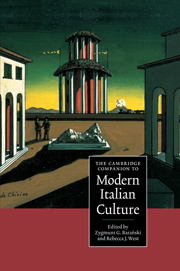Book contents
- Frontmatter
- Introducing modern Italian culture
- 1 The notion of Italy
- 2 Social and political cultures in Italy from 1860 to the present day
- 3 Questions of language
- 4 Intellectuals, culture and power in modern Italy
- 5 Catholicism
- 6 Socialism, Communism and other ‘isms’
- 7 Other voices: contesting the status quo
- 8 Narratives of self and society
- 9 Searching for new languages: modern Italian poetry
- 10 Drama: realism, identity and reality on stage
- 11 Italian cinema
- 12 Art in modern Italy: from the Macchiaioli to the Transavanguardia
- 13 A modern identity for a new nation: design in Italy since 1860
- 14 Fashion: narration and nation
- 15 The media
- 16 Since Verdi: Italian serious music 1860-1995
- 17 Folk music and popular song from the nineteenth century to the 1990s
- 18 Epilogue: Italian culture or multiculture in the new millennium?
- Index
- Series List
14 - Fashion: narration and nation
Published online by Cambridge University Press: 28 May 2006
- Frontmatter
- Introducing modern Italian culture
- 1 The notion of Italy
- 2 Social and political cultures in Italy from 1860 to the present day
- 3 Questions of language
- 4 Intellectuals, culture and power in modern Italy
- 5 Catholicism
- 6 Socialism, Communism and other ‘isms’
- 7 Other voices: contesting the status quo
- 8 Narratives of self and society
- 9 Searching for new languages: modern Italian poetry
- 10 Drama: realism, identity and reality on stage
- 11 Italian cinema
- 12 Art in modern Italy: from the Macchiaioli to the Transavanguardia
- 13 A modern identity for a new nation: design in Italy since 1860
- 14 Fashion: narration and nation
- 15 The media
- 16 Since Verdi: Italian serious music 1860-1995
- 17 Folk music and popular song from the nineteenth century to the 1990s
- 18 Epilogue: Italian culture or multiculture in the new millennium?
- Index
- Series List
Summary
There is a scene in Il Gattopardo ('The Leopard', 1958), the novel by Giuseppe Tomasi di Lampedusa (1896-1957), in which the character of Don Calogero, who represents the new aspiring bourgeois class, is invited for the first time to dinner at the Prince of Salina's summer residence. The Prince, who is also the narrator of the novel, describes Don Calogero's arrival with a high degree of stylistic virtuosity. Don Calogero - we are told - is the only guest who is not appropriately dressed for the occasion. In fact,he is wearing a formal frock-coat since he wants to show the aristocratic Salina family that he is wealthy enough to afford one. The Prince, however, is wearing an afternoon suit, as he has always done at his rural retreat in order not to embarrass the locals. Don Calogero's outfit is a real 'catastrophe' not so much for its fine fabric as for its cut, which reveals his stinginess and lack of style as he has chosen an incompetent local tailor instead of relying, as the true aristocrats did, on a more expert and expensive tailor based in England. In addition to this fault, the Prince remarks that not only are Don Calogero's shoes wrong but his shirt-collar is shapeless, details which act as clues to his defining trait: his hopeless lack of refined manners and elegance, despite his newly acquired wealth.
- Type
- Chapter
- Information
- The Cambridge Companion to Modern Italian Culture , pp. 283 - 292Publisher: Cambridge University PressPrint publication year: 2001
- 4
- Cited by



